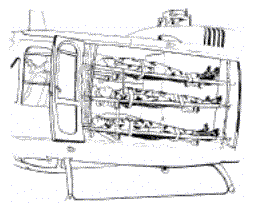The UH-lH/V Iroquois* |
| This aircraft may be used as a dedicated air
ambulance or as an airlift of opportunity.
There are three basic medical configurations:
In addition to the physical space inside the cabin, maximum load of the helicopter must also be considered. Maximum load varies with altitude, temperature, and fuel. The pilot will advise the ground personnel of his/her load capacity. Litter patients are normally loaded top to bottom, with the most seriously injured on the bottom. Patients receiving IV fluids should not be placed in the upper tier as there is not enough space between the roof of the cabin and the patient to insure good gravitational flow of IV fluids. Litter patients with Hare traction splints, splint supports and foot rests should be loaded last and placed directly on the floor of the helicopter. Unless a medical team is dispatched with the helicopter, it will have no medical personnel or equipment aboard, other than aircrew first aid kits. |
 UH-1 |
*From Operational Medicine 2001, Health Care in Military Settings, NAVMED P-5139, May 1, 2001, Bureau of Medicine and Surgery, Department of the Navy, 2300 E Street NW, Washington, D.C., 20372-5300
Contents · Introduction · Learning Objectives · Textbook · Lectures · Procedures · Final Exam · Library · Laboratory · Pharmacy · Imaging · Forms · Videos · Search · About the Author · Contact Us
Military Obstetrics & Gynecology
© 2005
Medical Education Division,
Brookside Associates, Ltd.
All rights reserved

